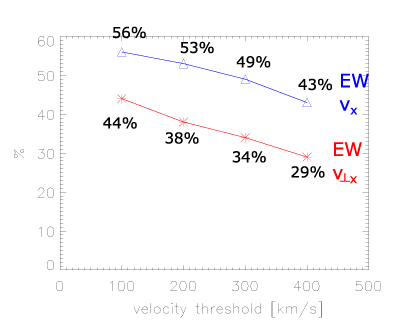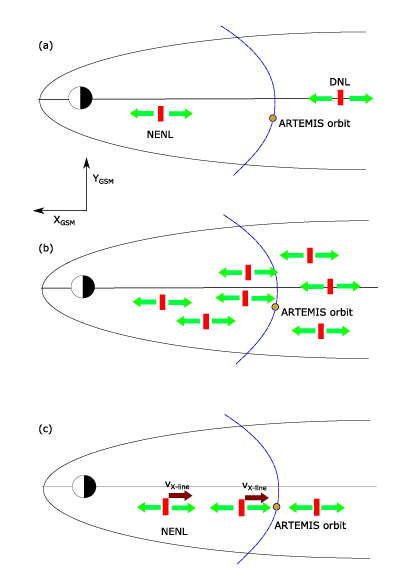2018 ARTEMIS SCIENCE NUGGETS
Fast plasma sheet flows in the Earth's distant magnetotail
by Stefan Kiehas
Space Research Institute, Graz, Austria
Introduction
Fast plasma sheet flows are significant for the understanding of magnetosphere dynamics. During the last decades, most observations of these flows took place within XGSM >−60 RE, i.e., within lunar orbit. The ARTEMIS probes, orbiting the moon, are excellent observation points to study fast flows beyond the previous observation domain. Previous studies of flows and other magnetotail transients revealed a preferred occurrence in the dusk sector, indicating a higher geomagnetic activity in the magnetotail’s dusk sector. The question arises if this dawn-dusk asymmetry is a near-Earth phenomenon or if it is also found deeper in the magnetotail.
| Figure 1. Orbits of ARTEMIS spacecraft P1 (red) and P2 (green) from 2011 to 2015. |
Database
This study covers 58 ARTEMIS magnetotail crossings from January 2011 to October 2015. The orbits during this period are shown in Figure 1. To remove mantle, boundary, and magnetosheath flows, we selected samples where the ion temperature exceeds 300 eV and the ion density remains under 0.5 cm−3. Most of the time the plasma sheet was quiet (vx < |100| km/s), leaving about 24% of the plasma sheet samples for this analysis.
| Figure 2. Percentage of earthward flows for different velocity thresholds applied to vx (blue) and v⊥x (red). |
Fast flow occurrence rate
We find that flows near lunar orbit are directed in almost equal parts both tailward and earthward. Figure 2 shows the percentage of earthward flows for several velocity thresholds. As can be seen, the percentage of earthward flows decreases to about 29% if only convective (v⊥x ) flows are considered. This decrease in the earthward fraction of flows for faster flow speeds is in line with magnetic reconnection as source of these flows and a decrease of the Alfvén velocity with increasing downtail distance to the Earth. Furthermore, we find more than 80% of all earthward flow data points to be accompanied by positive Bz and tailward flow data points predominantly accompanied by negative Bz. This is in line with magnetic reconnection as source mechanism of these flows and results from Earth’s magnetospheric configuration.| Figure 3. Histograms of flow data points exceeding the velocity threshold as written in the panels for (top row) earthward and (bottom row) tailward convective flows (v⊥x ). Pie charts show the percentage of flows observed in the dawn (red) and dusk (green) sectors. |
Dawn-Dusk asymmetry
While earthward flows do not show a dawn-dusk preference (with a slight dusk-side skew of flows with v⊥x >400 km/s), tailward flows show a clear tendency to be observed in the dusk sector (more than 60% of tailward flows are observed in the dusk sector), as can be seen in Figure 3. To address the question if the dawn-dusk asymmetry depends on geomagnetic activity, we show in Figure 4 the percentage of flow data points in the dusk sector exceeding |200| km/s relative to AL thresholds for both vx (top) and v⊥x (bottom). For tailward flows (red), the duskward asymmetry is similar for all AL thresholds. Earthward flows (blue) are fairly symmetrically distributed over both, dawn and dusk sectors for the lower AL thresholds (AL>0, AL>|200| nT), but they become strongly asymmetric toward the dusk sector for higher geomagnetic activity (AL>|400| nT).
| Figure 4. Percentage of flow data points with (top) vx >|200| km/s and (bottom) v⊥x >|200| km/s observed in the dusk sector relative to AL thresholds. |
Conclusions
- About half of the observed flows are directed earthward. The fraction of earthward flows decreases with flow speed.
- For convective flows (orthogonal to the magnetic field), the fraction of earthward flows is smaller, but still significant (about 29% for v⊥x flows exceeding |400| km/s).
- Earthward flows are predominantly accompanied by positive Bz, while tailward flows are accompanied by negative Bz.
- A dawn-dusk asymmetry in the flow occurrence is observed. Tailward convective flows are observed predominantly in the dusk sector, while earthward convective flows are nearly symmetrically distributed over the dawn and dusk sectors for weak substorms (AL>−400 nT) and observed predominantly in the dusk sector for strong substorms (AL>400 nT).
| Figure 5. Three possibilities for the X-line source of tailward and earthward flows observed with ARTEMIS. From top to bottom, (a) the classical NENL-DNL concept, (b) patchy reconnection with a gradual decrease of the dawn-dusk asymmetry with downtail distance, and (c) a tailward moving X-line moving beyond ARTEMIS orbit. |
In Figure 5 we present three possibilities for the X-line source of earthward and tailward flows near lunar orbit: (a) the classical dual near-Earth neutral line (NENL) and distant neutral line (DNL) model (b) patchy reconnection over a broad magnetotail range (c) a tailward moving near-Earth X-line.
The statistical tendency of tailward convective flows to appear in the dusk sector indicates that X-lines form preferentially in the premidnight (dusk) sector earthward of XGSM ≈ −60 RE, while the lack of a clear asymmetry in earthward convective flows for weak substorms indicates that X-lines beyond XGSM≈ −60 RE are evenly active in both sectors. When substorms evolve beyond AL < −400 nT, the accumulation of flux transported to the near-Earth region forces the conditions for reconnection onset to move farther downtail, which is in line with concept (c) of a tailward retreating X-line. Therewith, the asymmetric behavior of the reconnection onset conditions progresses tailward as well—beyond −60 RE. However, our results can also be interpreted within concept (b), as the asymmetry condition of the reconnection location spreads throughout the magnetotail for AL < −400 nT, allowing reconnection to occur preferentially in the dusk sector at multiple locations during strong substorms. Concept (a) with a near-Earth X-line primarily in the dusk sector and a symmetrically extended distant neutral line, seems to be only applicable during weak substorms.
References
Kiehas, S. A., Runov, A., Angelopolos, V., Hietala, H., & Korovinksiy, D. ( 2018). Magnetotail fast flow occurrence rate and dawn‐dusk asymmetry at XGSM ~ −60 RE. Journal of Geophysical Research: Space Physics, 123, 1767– 1778. https://doi.org/10.1002/2017JA024776Biographical Note
Stefan Kiehas is a researcher at the Space Research Institute of the Austrian Academy of Sciences, working on current sheet stability and magnetotail transients, funded by the Austrian Science Fund (FWF).
 Please send comments/suggestions to
Emmanuel Masongsong / emasongsong @ igpp.ucla.edu
Please send comments/suggestions to
Emmanuel Masongsong / emasongsong @ igpp.ucla.edu




